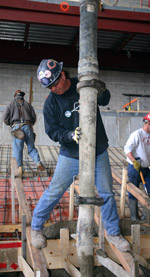| |
We’ve touched on the training & apprenticeship aspect on
this website, but this is the one that we probably field the
most questions about, so we’ll expand on the idea of a registered
Apprenticeship program here.
The US Department of Labor Employment & Training
Administration has summarized the topic very well, so we’ll use
their words here. Also, you can find more information at www.doleta.gov/oa/.
Apprenticeship, a proven training strategy that prepares
skilled workers, helps America compete more effectively in the
global economy, and contributes to our economic development, sustained
economic growth and national security.
Nationwide, 80,000 industries and companies offer
registered apprenticeship training to more than 395,000 apprentices.
These training programs serve a diverse population, including
minorities, women, youths and dislocated workers. Currently,
approximately 80% of all apprenticeship training positions
are in the construction and manufacturing industries. Experts
agree, however, that apprenticeship has the potential to benefit
numerous other industries, as well, including the service,
retail, and the public sector. With this in mind, the possibilities
for expanding apprenticeship -- and meeting the needs of many
more American companies and citizens in search of high quality training opportunities -- are virtually unlimited.
Registered apprenticeship programs are operated by
private industry - employer or labor/management sponsors. Registered
apprenticeship programs range from one to six or more years
in length. For the apprentice, this translates into an “industry
scholarship” worth $40,000 to $150,000. Since the content of
the training program is determined by industry needs, apprenticeship
produces workers with high demand skills. All this comes at
no cost to the government agency utilizing those skilled workers
and the training they are receiving.
 |
As a result of the Federal Apprenticeship Act of 1937,
the federal government (specifically the U.S. Department of
Labor’s Office of Apprenticeship Training, in cooperation with
the states) oversees the nation’s apprenticeship system. The
agency issues Certificates of Completion to apprentices, encourages
the development of new programs through marketing and technical
assistance, protects the safety and welfare of apprentices,
and ensures that all programs provide high-quality training
to apprentices.
The government’s return clearly outperforms other types
of government-sponsored job training programs. Apprentices “earn
as they learn,” and wages paid totally by the private sector
begin as soon as the apprentice enters training.
In sum, it makes
sense for contractors doing business on behalf of government
agencies to sponsor apprenticeship programs. It fosters an environment
of learning and education while helping to assure the highest
level of construction expertise possible.
It is also worth noting
that part of the prevailing wage requirement that contractors
must pay workers is allotted to training - if you look in detail
at prevailing wage requirements, there is a certain amount allotted
to base wages, pension, welfare and training. So, since a portion
of all wages paid to workers is going towards the training of
those workers, you might as well hire a contractor that utilizes
that allotment by participating in a training program.
|
|
